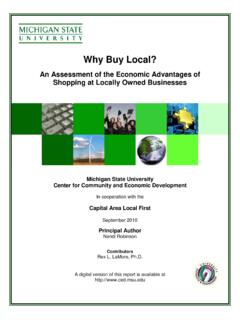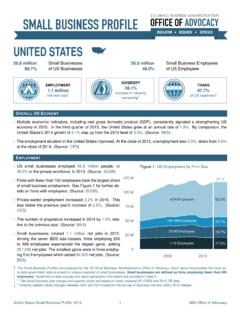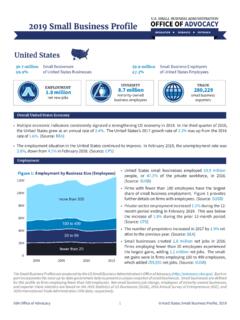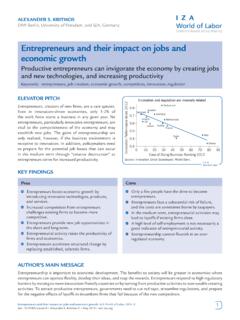Transcription of SMALL BUSINESSES AND ENTREPRENEURSHIP: A Project …
1 SMALL BUSINESSES AND entrepreneurship : A MICROFINANCE Project IN SANTA CLARA COUNTY A Project Report Presented to The Faculty of the Department of Anthropology San Jos State University In Partial Fulfillment of the Requirements for the Degree Master of Arts by Mayra S. Cerda May 2011 2011 Mayra S. Cerda ALL RIGHTS RESERVED SAN JOS STATE UNIVERSITY The Undersigned Graduate Committee Approves the Project Report Titled SMALL BUSINESSES AND entrepreneurship : A MICROFINANCE Project IN SANTA CLARA COUNTY by Mayra S. Cerda APPROVED FOR THE DEPARTMENT OF ANTHROPOLOGY _____ Dr. Charles Darrah, Department of Anthropology Date _____ Dr. English-Lueck, Department of Anthropology Date _____ Dr. Roberto Gonzalez, Department of Anthropology Date ABSTRACT One of the biggest challenges that SMALL BUSINESSES and immigrant entrepreneurs face is limited access to capital.
2 Microfinance organizations are trying to close this gap by targeting their financial products to those who do not qualify for a conventional banking loan. Opportunity Fund, a microfinance organization located in San Jos , California, was trying to reach out to two categories of clients and identify potential partners in Alum Rock without having to use too much manpower. This report documents the anthropological methods I employed; a summary of my interviews and observations; my experience attending the first microfinance conference held at Stanford University; and the lessons I learned throughout the course of this Project . I also discuss the opportunities for applied anthropologists in the field of microfinance and market research. v ACKNOWLEDGMENT I am truly indebted to my professor and advisor, Dr. Charles Darrah, for giving me the opportunity to lead this Project . Much appreciation also goes to Dr.
3 English-Lueck and Dr. Roberto Gonzalez, for their friendship and assistance. This Project would not have been possible without the help of my teammates and the community gatekeepers that gave me access to their organizations and clients. I am very fortunate to have parents who instilled in me the importance of education and hard work. Also, I am forever grateful to Seth D. Klinkhammer for his guidance and support throughout my educational journey at San Jos State University; he has always played a significant role in my life and education. Lastly, I would like to dedicate this research Project to the memory of two amazing men who taught me that perseverance is the key to accomplish your goals in life, Juan Manuel Papi Aguilar and Mr. Paul G. Klinkhammer. vi TABLE OF CONTENTS I. Introduction .. 1 II. Microfinance Programs Around the World .. 6 III. Getting to Know Opportunity Fund.
4 10 IV. Introduction of the Team .. 13 V. Project Overview .. 16 VI. Lessons 67 VII. Opportunities and Future Applications .. 70 VIII. Conclusion .. 72 Appendices A. Manpower Strategy/Check-in B. Opportunity Fund s Loan Preparation C. D. Opportunity Fund s vii LIST OF FIGURES 1. Identifying clients through community 2. Alum Rock community next to Central San Jos ..19 3. Opportunity Fund s Ideal Client Profile Decision 4. Strong and solid social capital between community viii LIST OF TABLES 1. List of community 2. Characteristics of Business Owners and Immigrant 1 INTRODUCTION In these challenging economic times, we are frequently reminded of the importance of SMALL BUSINESSES to our nation s economy. The media pays close attention to the role SMALL BUSINESSES or SMALL firms with fewer than 500 employees (Burrus and Stearns 1997:2) play in the economy because of the overall net job growth these firms have generated over the past 15 years.
5 Net job growth is the difference between gross job creation and gross job destruction. The most recent data available from the SMALL Business Administration Office of Advocacy reveals that SMALL SMALL BUSINESSES accounted million of the million net new jobs between 1993 and the third quarter of 2008 (2009:1). Women and minority entrepreneurs have made great strides in SMALL business ownership. The 2002 U. S. Census Bureau from the Survey of Business Owners (SBO) shows that women owned million non-farm firms. In 2007, the number of women-owned BUSINESSES increased to million (National Association of Women Business Owners). They are increasingly represented in non-traditional industries such as public transportation, business consulting, construction, and other types of services (Langowitz 2003; Center for Women's Business Research 2004). Minorities such as Hispanics, African Americans, Asians, American Indians or Alaskans are also creating SMALL BUSINESSES and generating employment.
6 The SMALL Business Administration Office of Advocacy (2009) reported that in 2002 minorities owned million firms that generated $694 billion in revenues and employed million people. In 2007, this number of minority-owned BUSINESSES in the increased to million 2 (SBO 2007). Such data indicates that women and minority entrepreneurs are key contributors to the creation of SMALL BUSINESSES . One of the biggest challenges these entrepreneurs face, due to the current economic downturn, is limited access to financial capital. Having access to credit, for example, is vital for entrepreneurs who wish to start or expand their own SMALL BUSINESSES , and financial institutions are key contributors in providing such financial access. Unfortunately, while these institutions may work well for some, other business entrepreneurs struggle to qualify for a SMALL business loan because of poor credit history (Barr 2004) or lack of collateral.
7 Immigrants are a good example of entrepreneurs who struggle to qualify for a conventional bank loan to start a business, despite the high probability that they will repay their loans. Part of the problem is that some immigrant entrepreneurs may lack conventional documentation available to citizens and/or may also have limited abilities to speak English and minimal experience dealing with the banking system. Because access to credit is critical to immigrant entrepreneurs and SMALL business owners, I developed a Project with the goal of helping a microfinance organization find immigrant entrepreneurs and SMALL business owners in need of capital to start or to expand their BUSINESSES . This report will detail: 1) my process of engaging ethnographic methods to gather my data, 2) my findings, and 3) my experience working with a microfinance organization. As an applied anthropologist, I wanted to help address the financial difficulties that entrepreneurs are encountering because of our nation s current economic downturn.
8 I also wanted to help the representatives of a 3 microfinance program learn how to reach out to entrepreneurs seeking financial services. In this introduction, I will explain the importance of applying anthropology in this Project and define the theory I used as part of my approach. Why Applied Anthropology According to Stuart Plattner (1989:2), anthropology is the cover term for the subdisciplines of archeology, physical anthropology, cultural anthropology, and anthropological linguistics. The discipline teaches researchers to look at the human experience from a holistic perspective, meaning that people s lives are studied in the context of their many activities, statuses, and roles (1989:3). One method that anthropologists use in their quest for holism is ethnographic research, which includes open ended, structured, and semi-structured interviews; participant-observation and network analysis (LeCompte and Schensul 1999; Pelto and Pelto 1978; Spradley 1979).
9 Ethnographic research has broad implications in many fields, including health care, business, and education. This type of research gives deep insight into understanding how other people see their experience (Spradley 1979:iv). By using the skills, perspectives, and methodologies that anthropology offers, applied anthropologists or anthropologists who work outside academia help solve human problems and facilitate change (Chambers1985:8). Rather than using anthropological knowledge to study only communities, anthropology has been put to use for practical purposes such as policy analysis and implementation, needs assessments, and program evaluation (Ervin 2005). An important lesson learned from applied anthropology is that researchers must think and communicate pragmatically. Peacock, in 4 The Future of Anthropology, promotes this lesson and points out that as anthropologists we bring perspectives to narrower domains (1997:16).
10 For that reason, the goal of this Project is an attempt to apply anthropology (1) to address a program s concern of: how a microfinance program can reach out to immigrant entrepreneurs and business owners in need of financial assistance, and (2) how to help a microfinance program strengthen its relationship with community organizations. Theoretical Approach This section covers the definitions of social capital and weak ties. These theoretical approaches were applied to this Project in order to understand how business entrepreneurs and community organizations are linked through relationships that are created to obtain information and resources. Social Capital Some of us have heard from or said to others, It is not what you know, it is who you know. This popular and common aphorism can simplistically describe how we understand the concept of social capital. Through our personal and professional experiences we learn that when we fall upon hard times we rely on our safety net, meaning friends and family.
















